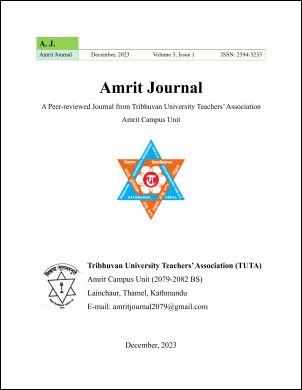Antibiotic Resistant Profile of Coliform and Staphylococcus aureus Isolated from Paneer Sample of Kathmandu Valley
DOI:
https://doi.org/10.3126/amritj.v3i1.61539Keywords:
Antibiotic susceptibility test, coliforms, methicillin resistant S. aureus, multiple-antibiotic resistant, paneer, Staphylococcus aureus, total bacterial countAbstract
Microbial contamination with antibiotic- resistant bacteria are major threats to public health in Nepal. This study aims to detect microbial quality of paneer and determine antibiotic susceptibility pattern of coliforms and S. aureus isolated from Paneer. For this, 30 paneer samples were randomly collected from dairy shops in Kathmandu and respective bacterial count were determined by using pour plate technique. All isolated organisms were identified by biochemical tests using appropriate selective media. Antibiotic Susceptibility Testing (AST) was carried out by Kirby Bauer disk diffusion method. In this study, Total Bacterial Count (TBC) of 18 (60.1%) samples, Total Coliform Count (TCC) of 5 (16.6%) samples and Total Staphylococcal Count (TSC) of 6 (50%) samples were within the limit of FSSAI guideline (2012). A total of forty-six bacteria were isolated in this study, of which 34 (73.9%) were identified as coliforms and 12 (26.1%) were identified as S. aureus. The coliform bacteria showed higher resistance towards Azithromycin (100%) followed by Cefoxitin, Ampicillin, Amikacin, Levofloxacin, Nalidixic acid, Chloramphenicol, Tetracycline and Gentamicin in descending order. While in case of S. aureus, higher resistance was shown against Penicillin. G (41.7%) and Nalidixic acid (41.7%) followed by Cefoxitin, Ampicillin, Azithromycin, Chloramphenicol and Levofloxacin. 4 (33.4%) MRSA were identified based on their full resistance towards Cefoxitin. Also, 24 multiple-drug resistance (MDR) bacteria were detected and higher MDR was observed among coliforms 21 (87.5%). To summarize, the maximum number of samples exceeding microbial quality specification and presence of multiple antibiotic resistance among isolated bacteria signifies poor quality of the paneer available in the market and can be considered a possible threat to consumers. Therefore, it is utmost necessary to monitor and control the quality of paneer sold in Kathmandu.
Downloads
Downloads
Published
How to Cite
Issue
Section
License
Copyright (c) 2023 Manisha Pradhan, Vagyashree Khanal, Atmaz Kumar Shrestha, Suchitra Thapa

This work is licensed under a Creative Commons Attribution 4.0 International License.
This license enables reusers to distribute, remix, adapt, and build upon the material in any medium or format, so long as attribution is given to the creator. The license allows for commercial use. Credit must be given to the creator.




